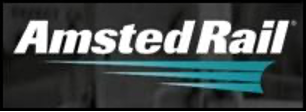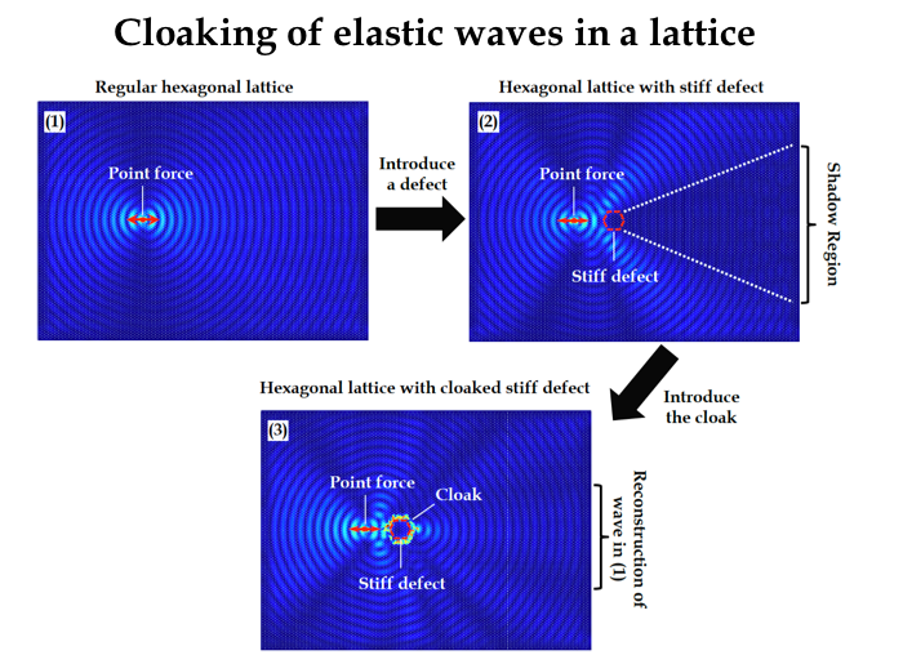Multi-scale modelling of nano and meta materials
We carry out research in the mathematics and mechanics of nano and meta-materials; strongly inhomogeneous micro-structured solids. For more information on PhD opportunities, please see here.
A profound similarity between the asymptotic procedures governing dynamic behaviour of thin and periodic structures is established in [1], see also [2]. High-frequency homogenisation technique [3] is developed for analysing the most exciting physical effects including ultra-refraction and all-angle negative refraction [4]. More recently, multimode approximations for periodic structures were obtained in [5].
- Craster, R. V., Joseph, L. M., & Kaplunov, J. (2014). Long-wave asymptotic theories: the connection between functionally graded waveguides and periodic media. Wave Motion, 51(4), 581-588.
- Kaplunov, J., Prikazchikov, D. A., & Prikazchikova, L. A. (2017). Dispersion of elastic waves in a strongly inhomogeneous three-layered plate. International Journal of Solids and Structures, 113, 169-179.
- Craster, R. V., Kaplunov, J., & Pichugin, A. V. (2010). High-frequency homogenization for periodic media. Proceedings of the Royal Society A: Mathematical, Physical and Engineering Sciences, 466(2120), 2341-2362.
- Craster, R. V., Kaplunov, J., Nolde, E., & Guenneau, S. (2011). High-frequency homogenization for checkerboard structures: defect modes, ultrarefraction, and all-angle negative refraction. JOSA A,28(6), 1032-1040
- Colquitt, D. J., Danishevskyy, V. V., & Kaplunov, J. (2019). Composite dynamic models for periodically heterogeneous media. Mathematics and Mechanics of Solids, 24(9), 2663-2693
An optimal 2D asymptotic theory for an elongated nanotube in the form of a thin cylindrical shell has been presented in [1]. It has been found that the most pronounced dynamic phenomena in nanotubes are associated with the vicinity of the lowest cut-off frequency. The effect of weak nonlinearity has been addressed in [2]. Comparison with 3D results have been highlighted in [3].
- Kaplunov, J., Manevitch, L. I., & Smirnov, V. V. (2016). Vibrations of an elastic cylindrical shell near the lowest cut-off frequency. Proceedings of the Royal Society A: Mathematical, Physical and Engineering Sciences, 472(2189), 20150753.
- Andrianov, I. V., Kaplunov, J., Kudaibergenov, A. K., & Manevitch, L. I. (2018). The effect of a weak nonlinearity on the lowest cut-off frequencies of a cylindrical shell. Zeitschrift für angewandte Mathematik und Physik, 69(1), 7.
- Ege, N., Erbaş, B., & Kaplunov, J. (2020). Asymptotic derivation of refined dynamic equations for a thin elastic annulus. Mathematics and Mechanics of Solids, 1081286520944980.
Explicit asymptotic models for surface elastic waves contain a wave equation on the boundary and a pseudo-static equation over the interior. These models are first established within various contexts of isotropic elasticity, see [1], and more recently are generalised to arbitrary anisotropy [2]. They appear to be very instrumental for modelling and optimisation of seismic meta-surfaces [3, 4].
- Kaplunov, J., & Prikazchikov, D. A. (2017). Asymptotic theory for Rayleigh and Rayleigh-type waves. Advances in Applied Mechanics(Vol. 50, pp. 1-106). Elsevier.
- Fu, Y., Kaplunov, J., & Prikazchikov, D. (2020). Reduced model for the surface dynamics of a generally anisotropic elastic half-space. Proceedings of the Royal Society A, (special volume dedicated to P. Chadwick, FRS) 476(2234), 20190590.
- Ege, N., Erbaş, B., Kaplunov, J., & Wootton, P. (2018). Approximate analysis of surface wave-structure interaction. Journal of Mechanics of Materials and Structures, 13(3), 297-309.
- Wootton, P. T., Kaplunov, J., & Colquitt, D. J. (2019). An asymptotic hyperbolic–elliptic model for flexural-seismic metasurfaces. Proceedings of the Royal Society A, 475(2227), 20190079.
A number of modern engineering applications, e.g. photovoltaic structural elements, are involving materials with high contrast in physical and geometric properties. An obvious complication of modelling such materials is associated with a large number of problem parameters. It has been demonstrated that one of the important phenomena associated with high contrast in both multi-span [1,2] and periodic structures [3] is extra low-frequency spectra. In case of layered structures this opens an exciting prospective for consistent approximate theories [4].
- Kaplunov, J., Prikazchikov, D. A., Prikazchikova, L. A., & Sergushova, O. (2019). The lowest vibration spectra of multi-component structures with contrast material properties. Journal of Sound and Vibration, 445, 132-147.
- Şahin, O., Erbaş, B., Kaplunov, J., & Savšek, T. (2020). The lowest vibration modes of an elastic beam composed of alternating stiff and soft components. Archive of Applied Mechanics, 90(2), 339-352.
- Kaplunov, J., & Nobili, A. (2017). Multi‐parametric analysis of strongly inhomogeneous periodic waveguideswith internal cutoff frequencies. Mathematical Methods in the Applied Sciences, 40(9), 3381-3392.
- Prikazchikova, L., Ece Aydın, Y., Erbaş, B., & Kaplunov, J. (2020). Asymptotic analysis of an anti-plane dynamic problem for a three-layered strongly inhomogeneous laminate. Mathematics and Mechanics of Solids, 25(1), 3-16.
Collaborators


Metamaterials are engineered media that possess remarkable properties not found in conventional materials. We design new metamaterials capable of controlling mechanical processes such as vibration. In addition, we create new tools to provide innovative techniques for designing these systems.

One range of metamaterials we analyse are mechanical lattices, formed from periodically connecting engineering building blocks e.g. beams, rods, masses etc. They can be easily designed and this provides a wide range of flexibility for material designers looking to construct new materials. A mechanical lattice utilises its microstructure to create very special responses to dynamic and static loads. Recent activities, based on creating novel models of how gyroscopes influence engineering elements [1, 2], have indicated this research paradigm can open new pathways in designing waveguides and cloaks that can impact the design of seismic protection devices [3]. Gyroscopic lattice systems may also be designed to support unusual one-way waves along interfaces [3, 4] and surface waves with preferential directions [5]. Similar design procedures can also be employed to create gyroscopic lattice systems that sustain the propagation of highly localised waveforms [6].
- G. Carta, M.J. Nieves, I.S. Jones, N.V. Movchan, A.B. Movchan, (2018): Elastic chiral waveguides with gyro-hinges, Q. J. Mech. Appl. Math 71, no.2, 157-185.
- M.J. Nieves, G. Carta, I.S. Jones, N.V. Movchan, A.B. Movchan, (2018): Vibrations and elastic waves in chiral multi-structures, J. Mech. Phys. Solids 121, 387-408.
- M. Garau, M.J. Nieves, G. Carta, M. Brun, (2019): Transient response of a gyro-elastic structured medium: unidirectional waveforms and cloaking, Int. J. Eng. Sci. 143, 115-141.
- M. Garau, G. Carta, M.J. Nieves, I.S. Jones, N.V. Movchan, A.B. Movchan, (2018): Interfacial waveforms in chiral lattices with gyroscopic spinners, Proc. Roy. Soc. A. 474, 20180132.
- Nieves, M.J., Carta, G., V. Pagneux, M. Brun (2020): Rayleigh waves in micro-structured gyroscopic systems: Non-reciprocity and energy symmetry breaking, Int. J. Eng. Sci. (accepted).
- G. Carta, I.S. Jones, N.V. Movchan, A.B. Movchan, M.J. Nieves, (2017): “Deflecting elastic prism” and unidirectional localisation for waves in chiral elastic systems, Sci. Rep. 7, no. 26.
Collaborators:
- Professor Michele Brun, University of Cagliari, Italy
- Dr Giorgio Carta, University of Cagliari, Italy
- Professor Ian Jones, Liverpool John Moores University, UK
- Professor Alexander Movchan, University of Liverpool, UK
- Professor Natasha Movchan, University of Liverpool, UK
- Professor V. Pagneux, Le Mans Université, France
People
- Surface waves on elastic half-spaces with anisotropic or periodic material properties (Professor Yibin Fu)
- Robust shell theories for nanotubes (Professor J. D. Kaplunov)
- Structured waveguides with applications to seismic protection (Dr Mike Nieves)
- Explicit asymptotic models for meta-surfaces (Dr D. Prikazchikov)
- Vibrations of high-contrast materials (Dr L. Prikazchikova)
Current
- Dominic Emery (Supervisor: Yibin Fu)
- Ali Mohammed Mubaraki (Supervisor: Danila Prikazchikov)
- Roza Sabirova (Supervisor: Julius Kaplunov, Danila Prikazchikov)
- Andreas Chorozoglou (Supervisor: Julius Kaplunov)
Recent
- Mohammed Alkinidri (Supervisor: Julius Kaplunov)
- Ali Althobaiti (Supervisor: Yibin Fu)
- Saad Althobaiti (Supervisor: Danila Prikazchikov)
- Saad Althobaiti (Supervisor: Danila Prikazchikov)
- Ahmed Alzaidi (Supervisor: Julius Kaplunov)
- Roman Chebakov (Supervisor: Julius Kaplnov)
- Roman Chebakov (Supervisors: Julius Kaplunov, Graham Rogerson)
- Marta Garau (Supervisor: Mike Nieves)
- Geethamala Francis (Supervisor: Yibin Fu)
- Maha Helmi (Supervisor: Ludmila Prikazchikova)
- Olga Sergushova (Supervisor: Danila Prikazchikov)
- Anna Shestakova (Supervisor: Julius Kaplunov)

